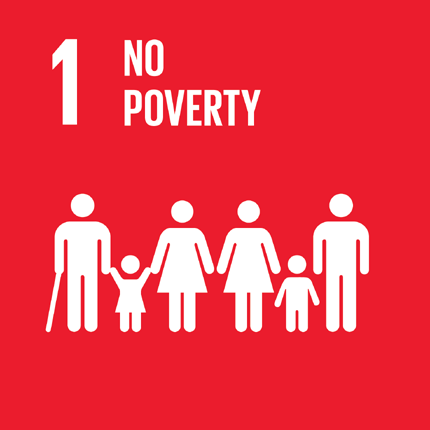sdg1
SUSTAINABLE DEVELOPMENT GOAL 1
End poverty in all its forms everywhere
Progress of goal 1
- Goal 1 calls for an end to poverty in all its manifestations by 2030. It also aims to ensure social protection for the poor and vulnerable, increase access to basic services and support people harmed by climate-related extreme events and other economic, social and environmental shocks and disasters.
- The international poverty line is currently defined at $1.90 or below per person per day using 2011 United States dollars purchasing power parity (ppp). In the decade beginning in 2002, the proportion of the world’s population living below the poverty line dropped by half, from 26 per cent to 13 per cent. If growth rates during those 10 years prevail for the next 15 years, the global extreme poverty rate will likely fall to 4 per cent by 2030, assuming that growth benefits all income groups of the population equally. However, if the growth rates over the longer period of 20 years prevail, the global poverty rate will likely be around 6 per cent. In other words, eliminating extreme poverty will require a significant change from historical growth rates.
- In 2015, 10.2 per cent of the world’s workers were living with their families on less than $1.90 per person per day, down from 28 per cent in 2000. Young people are especially likely to be among the working poor: 16 per cent of all employed youth aged 15 to 24 were considered working poor, compared to 9 per cent of adults.
- Expanding social protection programmes and targeting appropriate schemes to the poor and most vulnerable can further reduce poverty. Social protection programmes include social assistance, such as cash transfers, school feeding and targeted food assistance, as well as social insurance and labour market programmes, including old-age pensions, disability pensions, unemployment insurance, skills training and wage subsidies, among others.
- Social protections have expanded globally since 2000, as many developing countries adopted policies that afford protection for multiple contingencies. Pension coverage in particular is expanding rapidly. Over half (51 per cent) of people above retirement age received a pension according to data available for the period from 2010 to 2012. Almost all countries have child or maternity benefit programmes, and cash transfer schemes are increasing.
- Despite progress over the past decade, increasing social protection for those most in need remains a priority. Globally, 18,000 children still die each day from poverty-related causes, and only 28 per cent of employed women are effectively protected through contributory and non-contributory maternity cash benefits. Most poor people remain outside social protection systems, especially in low-income countries. Of the entire population, only 1 out of 5 receive any type of social protection in low-income countries, compared with 2 out of 3 in upper-middle-income countries. The coverage gap is particularly acute in sub-Saharan Africa and Southern Asia, where most of the world’s poorest people live. In sub-Saharan Africa, only 15 per cent of those in the bottom income quintile have access to a social protection benefit.
- Disaster risk reduction is essential to ending poverty and fostering sustainable development. Disaster risk is disproportionally higher in poorer countries with weaker institutions. In low- and lower-middle-income countries experiencing rapid economic growth, the exposure of people and assets to natural hazards is increasing at a faster pace than that at which risk-reducing capacities are being strengthened, leading to increased disaster risk.
- Economic losses from internationally reported disasters, principally large-scale disasters, have grown steadily since 1990, reaching an estimated annual average of $200 billion in 2013. Reported damage to housing, schools and health-care facilities, along with agricultural production, shows statistically significant upward trends from 1990 onwards.
Source: United Nations, Department of Economic and Social Affairs, SUSTAINABLE DEVELOPMENT KNOWLEDGE PLATFORM
The National Indicators for Sustainable Development Goal 1 are:
- Proportion (%) of population living below the national poverty line, by sex and age
- Proportion (%) of men, women and children of all ages living in poverty in all its dimensions according to national definitions
- Proportion (%) of population living in households with access to basic services
- Proportion of total government spending on essential services (education, health and social protection) (%)
- People at risk of poverty or social exclusion (%)
- People at risk of income poverty after social transfers (%)
- Severely material and social deprivation rate (%)
- People living in households with very low work intensity (%)
- Self-reported unmet need for medical care by detailed reason (%)
- Population unable to keep home adequately warm by poverty status (%)
- Overcrowding rate by poverty status (%)
All available data in .xls file:
- No poverty
Last Updated: 5/5/2025
EU SDG indicator set
To measure SDG achievement in an EU context, an EU SDG indicator set was developed under the leadership of Eurostat. The purpose of this set, which is structured along the 17 global Sustainable Development Goals, is to monitor progress towards the SDGs at the European level.
- For the complete set of indicators available in the Eurostat database, click here.
- To compare Greece’s progress on specific indicators for each Sustainable Development Goal, click here [data visualisation].

